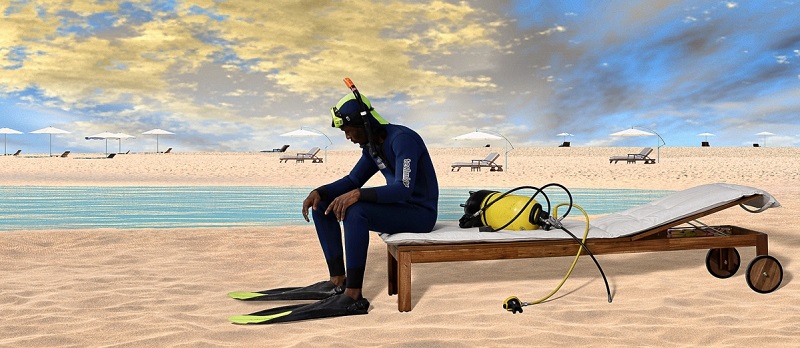For those who believe the aesthetic experience is an intellectual and sensitive exchange, for whom the communication between the piece of art and the viewer should be intimate and personal, the expression «cultural tourism» is almost an oxymoron.
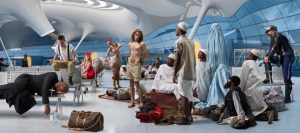
Within the «must-see» museums is reproduced on a small scale what usually happens on an urban scale: the tourist goes through the corridors as transit zones to get in front of a «required selfie» masterpiece, and once there he has to compete with others to take home a sweet souvenir smile.
To travel no longer stretches the mind, rather shrinks the heart, starting with the crowded airports, a waiting rooms to destinations that disappoint expectations or, if they are fulfilled, the boredom will overcome facing a too predictable journey.
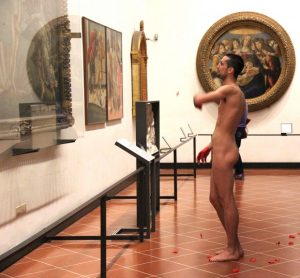
Eugenio Ampudia has called the tourism a comfortable hell, AES+F compared an airport with purgatory (Allegory Sacra), Santiago Talavera imagined the cathartic catastrophe of artificial paradises, Adrián Pino Olivera has literally stripped himself in front of iconic works of the main museums to “bathe” in their metaphysical beauty (while managing to divert the selfie sticks from Botticelli’s Venus to his own person)…
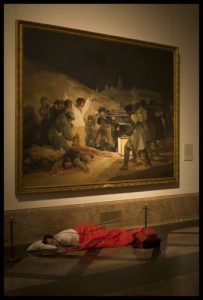
Museums calling for help in Morse code, museums taking off like rockets towards the void, cockroach plagues made with exhibitions invitation cards infesting the walls… Eugenio Ampudia has transmitted in very different ways the same concern: to massify the culture is not the same as to democratize it, to subordinate museum policies to the entrepreneurial principle undermines the critical potential of the aesthetic experience.
Museums calling for help in Morse code, museums taking off like rockets towards the void, cockroach plagues made with exhibitions invitation cards infesting the walls… Eugenio Ampudia has transmitted in very different ways the same concern: to massify the culture is not the same as to democratize it, to subordinate museum policies to the entrepreneurial principle undermines the critical potential of the aesthetic experience.
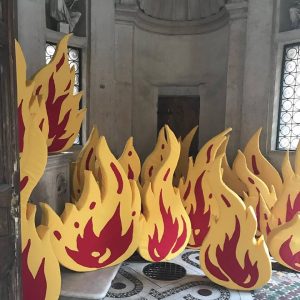
A comfortable hell was the title of an installation that Ampudia carried out in the Tempietto of San Pietro in Montorio, with flames-shaped cushions arranged on the circular floor and the crackle of the fire as a background sound. Together with the celestial symbolism of the Bramante’s dome as opposed to the underworld in which the visitor is comfortably installed, there are also more general ideas and ironic winks about the global warming and the masochism of the tourist that we all have inside.

Postcard-cities, brand-museums and star-artists are part of the same apparatus, as Chris Burden was quick to see in the eighties: “Samson” consisted of a turnstile placed at the entrance of an exhibition that counted the visits at the time that each turn of the bar increased the pressure of the structure against the walls.
But the Philistines are still crowding the temples. The columns do not never completely break. Luckily, the garden of tourism is spread over forking paths. There are those who prefer «extreme tourism», even «jumping to the margins of the map», as one of the seasonal workers interviewed by Herzog in Antarctica (Encounters at the End of the World) said. When we talk about extreme tourism, certainly, we focus on polar exploration, a trek to Everest or macabre tours in war zones. The human park extends its circus tent to the confines of the derangement.

Txema Salvans, however, gave us another gaze on a type of extreme leisure that is not aware of being extreme and doesn’t need to globe trot around the world to practice it. In photographic series such as Perfect Day, My kingdom or The Waiting game II, we see holidaymakers in swimsuits sticking their parasols in the most damaged landscapes of the Mediterranean coast, practicing recreational fishing next to petrochemicals plants or improvising picnics on suburban roads.
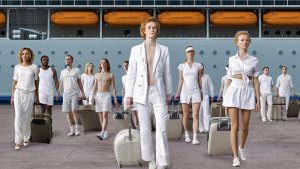
And at the polar opposite of these harden and resilient lives enjoying their vacations on cement beaches, we spot a few newly constructed island paradises over turquoise seas. In them, it fits all the money can buy. A frozen alpine landscape next to golden beaches, Chinese pagodas and neoclassical marble palaces, golf courses and ski slopes, labyrinthine flowerbeds and exotic birds. This is how AES+F imagined it in their video installation The Feast of Trimalchio (2010), the title of that satire by Petronius about a slave who amasses a fortune overnight.
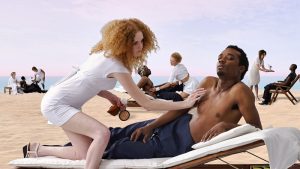
That freed slave would correlate with the contemporary new rich, free from the slavery of the wage earner who, not knowing what to do with his fortune, gives free rein to an insuperable kitsch taste.
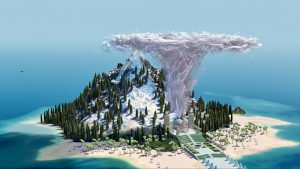
Caucasian tourists are welcomed by servants of all ethnicities. The relationships between one and the other will go through different phases of eroticization, humiliation and reversal of roles. Finally, what looks like a natural catastrophe has a lot to do with a social tsunami.
Golf balls start to invade the clear sky like a plague of intelligent objects that turn against their owners, then falling on them and hitting their bodies.
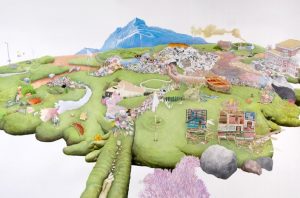
In one of the large drawings that formed the series The island of the voracious (2008) by Santiago Talavera we saw a golf hole becoming a kind of magnetic vortex. It is a curious coincidence that, in our view, creates a tunnel between both projects (Russian collective ones and Albacete artist) through this black and telluric hole. We imagine the escape of rebellious balls by the maelstrom and then causing the wreck of all these elitist parks, paradises packaged in miniaturized universes.
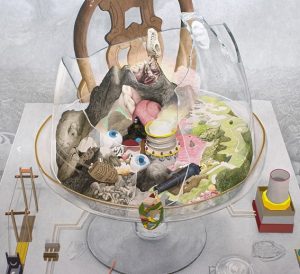
But the catastrophic event as cathartic renewal fails when the catastrophe seems to be part of the show.
Multiplying the perspectives, making the spaces more complex and overlapping the times, Talavera translated the state of oblivion (limbo) of those island-worlds with no past or future. The incongruous arrangement of snow-capped mountains and prefabricated houses on meadows threatened by giant carnivorous plants tells us of prophecies of disorder, as named another of his series (showing fairytale and disturbing landscapes), or in vitro landscapes, pieces of nature as souvenirs in glass urns.
In the future, entertainment could take the form of a grotesque human park where the search for increasingly extreme experiences is subject to an increasingly vigilant state. Bruce Bégout, who in his novel Le Park synthesizes all the possible parks on a private island of a Russian billionaire, reflected on that. An amalgam of an amusement park and a concentration camp, Le Park injects doses of spectacle, risk, sordidness and simulation in equal parts. It exploits the mimetic desire of visitors by offering them the possibility of virtually living a revolution in the Cabaret of Lost Utopias, or exchanging roles with the terrorists locked in the prisons of the arcades.
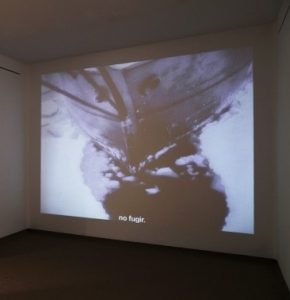
Geographical isolation offers an ideal setting for physical and mental experimentation. The island becomes the perfect framework to replace the suspension of the sense of reality with collective hallucination injections.
Le Park condenses all historical milestones in packaging or encapsulating the real: zoos, fairs, extermination camps, ghettos, nature reserves …, to the extent that actions such as classifying, protecting, isolating, taming, and even exterminating, end up being the same thing.
Because tourism is that, be it elite or massive, cultural or beach: when no longer exist the romantic belief on mind-broadening, what remains is to shrink the landscape and culture, stuff it into our narrow-mindedness.
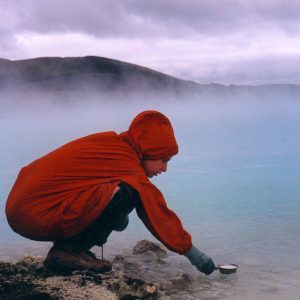
But there are artists who do not renounce that aspiration of the traveler of yesteryear. Alicia Kopf even discovered correlations between artistic practice and arctic explorers concerns: expeditions without any reward other than personal satisfaction, physical travel as a transcript of inner travel, stubbornness … She illustrated with her own creative process those similarities, acting as a cartographer, a mythologist, a writer … a solitary runner who traces her own psychogeographic maps, her own story intertwining with that of legendary pioneers.
Also, the artistic career of Ilana Halperin makes sense as a nomadic experience whose route is marked by eruptions, encounters with volcanologists, anecdotes from the past that she brings to the present by colliding history and geology, personal biography and seismic activity. The first station of her Nomadic Landmass (2003-06) was the island of Heimaey, where she celebrated her thirtieth birthday at the Eldfell volcano, which was formed the same year of the artist’s birth.
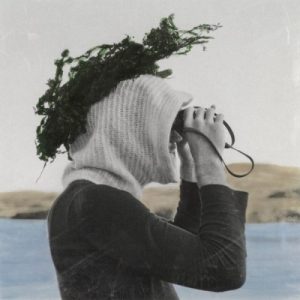
Although Cristina de Middel shows us in her Jan Mayen that the trick photography and the mystification of the exploratory journey go far back, that the need to take home a trophy even if it is false has always overtaken the truth of the story, we are still fascinated by those expeditions to the eternal snow, by the most inhospitable lands and by those who invented new toponyms.
After all, any map is an invention. So this summer we can choose to stay at home, replace so much external signaling by our internal radar, to land on one of the fifty islands I have not visited and never will that Judith Schalansky proposes in her Atlas of remote islands, and to become aware that behind the noblest libertarian motivations or longings of original states end up seedling the most brutal instincts, dreams of greatness or desires of wreck.
Anna Adell

